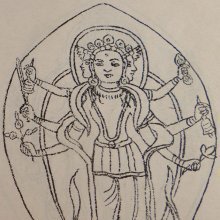Utpala: 34 definitions
Introduction:
Utpala means something in Buddhism, Pali, Hinduism, Sanskrit, Jainism, Prakrit, Hindi, biology. If you want to know the exact meaning, history, etymology or English translation of this term then check out the descriptions on this page. Add your comment or reference to a book if you want to contribute to this summary article.
Alternative spellings of this word include Utapl.
Images (photo gallery)
(+37 more images available)
In Hinduism
Ayurveda (science of life)
Dietetics and Culinary Art (such as household cooking)
Source: Shodhganga: Dietetics and culinary art in ancient and medieval IndiaUtpala (उत्पल) refers to the “blue lotus” according to the 17th century Bhojanakutūhala (dravyaguṇāguṇa-kathana).—The food-utensils that are made of Utpala-patra (blue lotus leaf) have the following dietetic effects: nindita, śīta, rūkṣa (scorned, cool, pungent) vṛṣya, klamahara and “yātrārthināṃ abhihita” (aphrodisiac, removes weariness and suitable for travellers).
Kalpa (Formulas, Drug prescriptions and other Medicinal preparations)
Source: Ancient Science of Life: Evaluation of Cyavanaprāśa on Health and Immunity related Parameters in Healthy ChildrenUtpala (उत्पल) refers to the medicinal plant known as Nymphaea stellata, Fl., and is used in the Ayurvedic formulation known as Cyavanaprāśa: an Ayurvedic health product that helps in boosting immunity.—Cyavanaprāśa has been found to be effective as an immunity booster, vitalizer and a preventer of day to day infections and allergies such as common cold and cough etc. It is a classical Ayurvedic formulation comprising ingredients such as Utpala. [...] Cyavanaprāśa can be consumed in all seasons as it contains weather friendly ingredients which nullify unpleasant effects due to extreme environmental and climatic conditions.
Source: Shodhganga: Edition translation and critical study of yogasarasamgrahaUtpala (उत्पल) refers to the medicinal plant known as “Nymphaea alba Linn.” and is dealt with in the 15th-century Yogasārasaṅgraha (Yogasara-saṅgraha) by Vāsudeva: an unpublished Keralite work representing an Ayurvedic compendium of medicinal recipes. The Yogasārasaṃgraha [mentioning utpala] deals with entire recipes in the route of administration, and thus deals with the knowledge of pharmacy (bhaiṣajya-kalpanā) which is a branch of pharmacology (dravyaguṇa).
Cikitsa (natural therapy and treatment for medical conditions)
Source: Ancient Science of Life: Botanical identification of plants described in Mādhava CikitsāUtpala (उत्पल) refers to the medicinal plant Nymphaea stellata Wild., and is used in the treatment of atisāra (diarrhoea), according to the 7th century Mādhavacikitsā chapter 2. Atisāra refers to a condition where there are three or more loose or liquid stools (bowel movements) per day or more stool than normal. The second chapter of the Mādhavacikitsā explains several preparations [including Utpala] through 60 Sanskrit verses about treating this problem.
Agriculture (Krishi) and Vrikshayurveda (study of Plant life)
Source: Shodhganga: Drumavichitrikarnam—Plant mutagenesis in ancient IndiaUtpala (उत्पल) (identified with Nymphaea caerulea) is used in the process of producing long lasting fruits (on the tree) [e.g., anāśi-phalatva], according to the Vṛkṣāyurveda by Sūrapāla (1000 CE): an encyclopedic work dealing with the study of trees and the principles of ancient Indian agriculture.—Accordingly, “A ball made out of the mixture of flowers of the Madhuca indica, Nymphaea caerulea [e.g., Utpala], honey, crystalline sugar and Glycyrrhiza glabra kept in a hole made at the root of a tree produces long lasting fruits (on the tree)”.
Unclassified Ayurveda definitions
Source: Wisdom Library: Āyurveda and botanyUtpala (उत्पल) is a Sanskrit word referring to Nymphaea alba (white water rose), a plant species in the Nymphaeaceae family. Certain plant parts of Utpala are eaten as a vegetable (śāka), according to Caraka in his Carakasaṃhitā sūtrasthāna (chapter 27), a classical Ayurvedic work. The plant is therefore part of the Śākavarga group of medicinal plants, referring to the “group of vegetables/pot-herbs”. Caraka defined such groups (vargas) based on the dietic value of the plant.
According to the Rājanighaṇṭu (verse 10.195), Utpala is identified with Nymphaea stellata (commonly known as Nymphaea nouchali, blue lotus), and lists the following synonyms: Anuṣṇa, Rātripuṣpa, Jalāhvaya, Himābja, Śītajalaja and Niśāphulla. The same work mentions Nymphaea alba as Dhavalotpala, being a variety of Utpala.
Properties according to Caraka-saṃhitā: The various types of Utpala are astringent and useful in internal haemorrhage.
Properties according to the Rājanighaṇṭu: Utpala is cooling, tasty and a cure for rakta-pitta (bleeding tendencies). It is beneficially indicated in burning sensations, exhaustion, vomiting, illusion, worms and fevers.
Usage: The rhizomes, tender leaves and peduncles are used as a pot-herb. Powdered rhizomes are given in piles, diarrhoea and dyspepsia. Infusion is emolient and diuretic and used in urinary tract disorders. Leaves are indicated in erysipelas. Seeds stomachic and restorative and are called Berā or Bhenṭ in Bihar. The decoction of flowers is narcotic.
Source: archive.org: Vagbhata’s Ashtanga Hridaya Samhita (first 5 chapters)Utpala (उत्पल) refers to the “blue nymphaea”, mentioned in verse 3.34-36 of the Aṣṭāṅgahṛdayasaṃhitā (Sūtrasthāna) by Vāgbhaṭa.—Accordingly, “[...] In groves in which the hot-rayed one is darkened by cloud-grazing huge Sal trees and Palmyra palms, [...] (and which is) covered with the shoots and fruit-pendants of mango-trees; (or) on a couch (which is) prepared from tender banana-leaves, white nymphaeas, lotus-fibres, nelumbos, and blue nymphaeas [utpala], (and) in which (are found) opening buds and sprouts: (there) one shall sleep at noon when pained by the heat of the sun; or in a bath-house”.

Āyurveda (आयुर्वेद, ayurveda) is a branch of Indian science dealing with medicine, herbalism, taxology, anatomy, surgery, alchemy and related topics. Traditional practice of Āyurveda in ancient India dates back to at least the first millenium BC. Literature is commonly written in Sanskrit using various poetic metres.
Vyakarana (Sanskrit grammar)
Source: Wikisource: A dictionary of Sanskrit grammarUtpala (उत्पल).—Author of a commentary on Pāṇini's Liṅgānuśāsana. It is doubtful whether he was the same as उत्पलभट्ट (utpalabhaṭṭa) or भट्टोत्पल (bhaṭṭotpala), the famous astrologer of the tenth century.

Vyakarana (व्याकरण, vyākaraṇa) refers to Sanskrit grammar and represents one of the six additional sciences (vedanga) to be studied along with the Vedas. Vyakarana concerns itself with the rules of Sanskrit grammar and linguistic analysis in order to establish the correct context of words and sentences.
Purana and Itihasa (epic history)
Source: archive.org: Shiva Purana - English TranslationUtpala (उत्पल) is the name of a flower used in the worship of Śiva, according to the Śivapurāṇa 2.1.11:—“[...] offerings of flowers, especially white flowers and rare flowers, shall be made to Lord Śiva. Flowers of Apāmārga, Karpūra, Jātī, Campaka, Kuśa, Pāṭala, Karavīra, Mallikā, Kamala (lotus) and Utpalas (lilies) of various sorts shall be used. When water is poured it shall be poured in a continuous stream”.
Source: JatLand: List of Mahabharata people and placesUtpala (उत्पल) refers to the name of a Forest mentioned in the Mahābhārata (cf. III.85.11). Note: The Mahābhārata (mentioning Utpala) is a Sanskrit epic poem consisting of 100,000 ślokas (metrical verses) and is over 2000 years old.

The Purana (पुराण, purāṇas) refers to Sanskrit literature preserving ancient India’s vast cultural history, including historical legends, religious ceremonies, various arts and sciences. The eighteen mahapuranas total over 400,000 shlokas (metrical couplets) and date to at least several centuries BCE.
Shaktism (Shakta philosophy)
Source: Brill: Śaivism and the Tantric Traditions (shaktism)Utpala (उत्पल) refers to a “red lily” and is used to describe the Mother-Goddesses (mātṛ), according to the King Vatsarāja’s Pūjāstuti called the Kāmasiddhistuti (also Vāmakeśvarīstuti), guiding one through the worship of the Goddess Nityā.—Accordingly, “[...] I take refuge with the goddesses of becoming minute and other great accomplishments for the sake of success. They hold wish-fulfilling jewels in both hands. They are moon-crested, three-eyed, and red in complexion. I revere Brahmāṇī and the other mother-goddesses. They carry a skull-bowl and red lily in their hands (utpala-dhāriṇī—kapālotpaladhāriṇī), their bodies are dark-colored like the leaves of bamboo, and they are clad in lovely [red] clothes resembling bandhūka flowers. [...]”.

Shakta (शाक्त, śākta) or Shaktism (śāktism) represents a tradition of Hinduism where the Goddess (Devi) is revered and worshipped. Shakta literature includes a range of scriptures, including various Agamas and Tantras, although its roots may be traced back to the Vedas.
Jyotisha (astronomy and astrology)
Source: Wikipedia: Jyotisha (astronomy)Utpala (उत्पल) or Bhaṭṭotpala (from Kashmir) is the name of a 10th-century Indian commentator of Vārāha Mihira’s Bṛhatsaṃhitā and Bṛhajjātaka.—The Bṛhatsaṃhitā is a Saṃhitā text of Jyotiṣa (Indian astrology and astronomy) . Saṃhitā is one of three branches of Jyotiṣa (Saṃhitā has many other meanings outside Jyotiṣa). Utpala is known for quoting six verses from Sūrya Siddhānta which are not found in its extant version. These six verses can be found in the ‘Introduction’ by S. Jain to the translation of Sūrya Siddhānta made by E. Burgess. Utpala is also the author of a commentary on Brahmagupta’s Khaṇḍakhādyaka (7th century). In this, he is a successor of Pṛthūdaka and a predecessor of Amaraja.

Jyotisha (ज्योतिष, jyotiṣa or jyotish) refers to ‘astronomy’ or “Vedic astrology” and represents the fifth of the six Vedangas (additional sciences to be studied along with the Vedas). Jyotisha concerns itself with the study and prediction of the movements of celestial bodies, in order to calculate the auspicious time for rituals and ceremonies.
Shaivism (Shaiva philosophy)
Source: SOAS University of London: Protective Rites in the Netra TantraUtpala (उत्पल) refers to a “blue lotus”, according to the Netratantra of Kṣemarāja: a Śaiva text from the 9th century in which Śiva (Bhairava) teaches Pārvatī topics such as metaphysics, cosmology, and soteriology.—Accordingly, [verse 9.19cd-26, while instructing to visualize Sadāśiva in order to worship the formless Amṛteśa]—“[He] resembles the swelling moon, a heap of mountain snow. Five-faced, large-eyed, ten-armed, [and] three-armed, [he] has a serpent as a sacred thread. He is covered in a garment made of tiger skin. [He] sits in the bound lotus pose atop a white lotus, [holding] a trident, blue lotus (utpala), arrow, rudrākṣa, [and] a mallet. [...]”.

Shaiva (शैव, śaiva) or Shaivism (śaivism) represents a tradition of Hinduism worshiping Shiva as the supreme being. Closely related to Shaktism, Shaiva literature includes a range of scriptures, including Tantras, while the root of this tradition may be traced back to the ancient Vedas.
Shilpashastra (iconography)
Source: Shodhganga: Elements of Art and Architecture in the Trtiyakhanda of the Visnudharmottarapurana (shilpa)Utpala (उत्पल) refers to “lotus” and follows specific guidelines of ancient Indian Painting (citra), according to the Viṣṇudharmottarapurāṇa, an ancient Sanskrit text which (being encyclopedic in nature) deals with a variety of cultural topics such as arts, architecture, music, grammar and astronomy.—The third variety of the eye should be in the shape of utpala-patra i.e., petals of blue lotus and its measurement should be six yavas. [...] The forth variety of eye should be in the shape of padma-patra i.e., petal of lotus flower and the size should be nine yavas. In the Kumārasambhava, Pārvatī is referred to utpalākṣyā i.e., one with the eyes in the shape of utpala i.e., lotus. The Viṣṇudharmottarapurāṇa states that the eyes of the scared and lamenting person should be in the shape of lotus petal.

Shilpashastra (शिल्पशास्त्र, śilpaśāstra) represents the ancient Indian science (shastra) of creative arts (shilpa) such as sculpture, iconography and painting. Closely related to Vastushastra (architecture), they often share the same literature.
In Buddhism
Mahayana (major branch of Buddhism)
Source: Wisdom Library: Maha Prajnaparamita Sastra1) Utpala (उत्पल) refers to a “lotus” (in the water), according to Mahāprajñāpāramitāśāstra (chapter 2).—Accordingly, “People of sensitive and upright mind can easily obtain salvation. If these people do not hear the doctrine preached, they fall into grave difficulties. It is like the lotus (utpala) in the water: some are born, some ripen, some remain within the water without emerging. If they do not have sunlight (sūryaprabhā), they do not expand (vikasanti). The Buddha is like [the sunlight]: sent forth by his great loving kindness and great compassion (mahāmaitrīkaruṇā), that he might have pity for beings and preach the doctrine”.
2) Utpala (उत्पल) is the name of an ancient king.—According to appendix 6 at Mahāprajñāpāramitāśāstra chapter IV.—When he was king Utpala, the Bodhisattva wrote a text of the Dharma with one of his broken bones as pen, his marrow as ink and his skin as parchment. This episode is told in the Kien yu king and P’ou sa pen jing king. The scene occurred at the Monastery of the Lentils (masūra-saṃghārāma) at Gumbatai, near Tursak, in Buner, and was visited by Song Yun and by Hiuan tsang. This episode is also told in the Mahāprajñāpāramitāśāstra, but the hero is the brahmin Ngai fa (Dharmarakta) or Lo fa (Dharmarata); besides, he writes the stanza “with his skin as parchment and his blood as ink”; there is no mention of marrow. Thus it is possible that the Mahāprajñāpāramitāśāstra, speaking of the “gift of marrow” was not thinking of this episode.
Note: In the “gift of marrow”, Lamotte rather see an allusion to the Jātaka where prince Candraprabha “broke one of his bones and pushed out the marrow to cure a sick man.” This deed is told by the Mahāprajñāpāramitāśāstra. It is also known to the Ratnakūta where the prince, like the Ṛṣi mentioned above is called Utpala. Also see the Candraprabha-jātaka from the 2nd century Mahāprajñāpāramitāśāstra (chapter XX).
3) Utpala (उत्पल) is the name of a hell according to the 2nd century Mahāprajñāpāramitāśāstra (chapter XXII).—Accordingly, “Twenty stays in the Huhuva hell equals one stay in the Ngeou po lo (Utpala) hell. – Twenty stays in the Utpala hell equal one stay in the Fen t’o li kia (Puṇḍarīka) hell”.
4) Utpala (उत्पल) refers to one of the “eight hells of cold water” forming part of the sixteen utsadas (secondary hells) sitauted outside of the eight great hells, according to the “world of transmigration” section in the 2nd century Mahāprajñāpāramitāśāstra (chapter XXVII).—Accordingly, “in the Utpala hell, the ice and mud are like a blue lotus (nīlotpala)”.
Note: According to the Kośa, III, p. 154, Utpala and Padma indicate the shape taken by the damned: they are like a blue or red lotus. According to the Chinese sources studied by Beal, Catena, p. 63, the inmates of Utpala and Padma are covered with spots resembling blue and red lotuses respectively.
Source: archive.org: Bulletin of the French School of the Far East (volume 5)Utpala (उत्पल) is the name of a Gandharva appointed as one of the Divine protector deities of Magadha, according to chapter 17 of the Candragarbha: the 55th section of the Mahāsaṃnipāta-sūtra, a large compilation of Sūtras (texts) in Mahāyāna Buddhism partly available in Sanskrit, Tibetan and Chinese.—In the Candragarbhasūtra, the Bhagavat invites all classes of Gods and Deities to protect the Law [dharma?] and the faithful in their respective kingdoms of Jambudvīpa [e.g., the Gandharva Utpala in Magadha], resembling the time of the past Buddhas.
Utpalā (उत्पला) is also the name of a Godddess appointed as one of the Divine protector deities of Caidya.
Utpalā (उत्पला) is also the name of an Goddess appointed as one of the Divine protector deities of Avanti.
Source: De Gruyter: A Buddhist Ritual Manual on AgricultureUtpala (उत्पल) refers to “blue lotuses” (covering the lotus-lake near Aḍakavatī), according to the Vajratuṇḍasamayakalparāja, an ancient Buddhist ritual manual on agriculture from the 5th-century (or earlier), containing various instructions for the Sangha to provide agriculture-related services to laypeople including rain-making, weather control and crop protection.—Accordingly, [when the Bhagavān reached the vicinity of the residence of Vaiśravaṇa], “[...] That lotus lake was covered by various blue lotuses (utpala), lotuses, white water-lilies and white lotuses. It contained various fish, Makaras, Timiṅgilas, alligators, bees and various other water-born beings. [...]”

Mahayana (महायान, mahāyāna) is a major branch of Buddhism focusing on the path of a Bodhisattva (spiritual aspirants/ enlightened beings). Extant literature is vast and primarely composed in the Sanskrit language. There are many sūtras of which some of the earliest are the various Prajñāpāramitā sūtras.
General definition (in Buddhism)
Source: Wisdom Library: Dharma-samgrahaUtpala (उत्पल) refers to the “blue-lotus hell” and represents one of the “eight cold hells” (śīta-naraka) as defined in the Dharma-saṃgraha (section 122). The Dharma-samgraha (Dharmasangraha) is an extensive glossary of Buddhist technical terms in Sanskrit (e.g., utpala). The work is attributed to Nagarjuna who lived around the 2nd century A.D.
In Jainism
General definition (in Jainism)
Source: archive.org: Economic Life In Ancient India (as depicted in Jain canonical literature)Utpala (उत्पल) refers to the “blue lotus”: a type of flower (puṣpa) commonly used in for personal and commercial purposes in ancient India. People were fond of flowers. The groves and gardens were maintained for recreational purpose. The Jain canonical texts frequently mention different horticulture products viz. fruits, vegetables and flowers which depict that horticulture was a popular pursuit of the people at that time. Gardens and parks (ārāma, ujjāṇa or nijjaṇa) were full of fruits and flowers of various kinds which besides yielding their products provided a calm andquiet place where people could enjoy the natural surroundings.
The flowers (e.g., Utpala) fulfilled the aesthetic needs of the people. At the same time they had an economic importance in as much as some people depended on its trade. It is mentioned that people of Koṅkaṇa maintained themselves by selling fruits and flowers. (see Bṛhatkalpasūtra) Flower garlands and bouquet of various designs were prepared and sold. Saffron (kuṃkuma or kesara) was an important flower product. It yielded a good income to the producers. The flower attracted the bees who yielded honey (mahu, sanskrit: madhu) of different varieties, e. g. macchiya, kuṭṭiya, bhāmara, etc.

Jainism is an Indian religion of Dharma whose doctrine revolves around harmlessness (ahimsa) towards every living being. The two major branches (Digambara and Svetambara) of Jainism stimulate self-control (or, shramana, ‘self-reliance’) and spiritual development through a path of peace for the soul to progess to the ultimate goal.
Biology (plants and animals)
Source: Wisdom Library: Local Names of Plants and DrugsUtpala [उत्पलः] in the Sanskrit language is the name of a plant identified with Kaempferia rotunda L. from the Zingiberaceae (Ginger) family. For the possible medicinal usage of utpala, you can check this page for potential sources and references, although be aware that any some or none of the side-effects may not be mentioned here, wether they be harmful or beneficial to health.
Source: Google Books: CRC World Dictionary (Regional names)1) Utpala in India is the name of a plant defined with Kaempferia rotunda in various botanical sources. This page contains potential references in Ayurveda, modern medicine, and other folk traditions or local practices It has the synonym Zerumbet zeylanica Garsault (among others).
2) Utpala is also identified with Nymphaea capensis It has the synonym Nymphaea bernierana Planch. (etc.).
3) Utpala is also identified with Nymphaea cyanea It has the synonym Nymphaea cyanea Roxb. & G. Don.
4) Utpala is also identified with Nymphaea nouchali It has the synonym Nymphaea capensis var. madagascariensis (DC.) Conard (etc.).
5) Utpala is also identified with Nymphaea stellata It has the synonym Nymphaea stellata F. Muell..
6) Utpala is also identified with Saussurea costus It has the synonym Aucklandia lappa Decne. (etc.).
Example references for further research on medicinal uses or toxicity (see latin names for full list):
· Revisio Generum Plantarum (1891)
· Acta Phytotaxonomica Sinica (1994)
· Repertorium Botanices Systematicae (1843)
· Linnaea (1846)
· Hort. Cantabrig., ed. 3 (1804)
· J. Cytol. Genet. (1971)
If you are looking for specific details regarding Utpala, for example health benefits, diet and recipes, pregnancy safety, extract dosage, side effects, chemical composition, have a look at these references.

This sections includes definitions from the five kingdoms of living things: Animals, Plants, Fungi, Protists and Monera. It will include both the official binomial nomenclature (scientific names usually in Latin) as well as regional spellings and variants.
Languages of India and abroad
Sanskrit dictionary
Source: DDSA: The practical Sanskrit-English dictionaryUtpala (उत्पल).—a. [utkrāntaḥ palaṃ māṃsam] Fleshless, emaciated, lean.
-lī A kind of cake made with unwinnowed corn.
-lam 1 A blue lotus, any lotus or water lily; नवावतारं कमलादिवोत्पलम् (navāvatāraṃ kamalādivotpalam) R.3.36,12.86; Meghadūta 26; नीलो- त्पलपत्रधारया (nīlo- tpalapatradhārayā) Ś.1.18; so रक्त° (rakta°).
2) The plant Costus Speciosus (koṣṭha).
3) A plant in general.
Source: Cologne Digital Sanskrit Dictionaries: Edgerton Buddhist Hybrid Sanskrit DictionaryUtpala (उत्पल).—(1) m., Mahāvyutpatti 7797, or nt., Mahāvyutpatti 7926 (cited from Gaṇḍavyūha) and Gaṇḍavyūha 106.19; 134.3, a high number; (2) m., name of a former Buddha: Mahāvastu iii.235.16; (3) m. (= Pali uppala, °laka), name of a (cold, Dharmasaṃgraha, Tibetan Mahāvyutpatti) hell: Mahāvyutpatti 4934; Dharmasaṃgraha 122; Divyāvadāna 67.23; 138.7; Avadāna-śataka i.4.9 etc.; (4) m., name of a kalpa: see Upala (and compare Utpalaka 3).
--- OR ---
Utpalā (उत्पला).—name of a rākṣasī: Mahā-Māyūrī 243.15.
Source: Cologne Digital Sanskrit Dictionaries: Shabda-Sagara Sanskrit-English DictionaryUtpala (उत्पल).—mfn.
(-laḥ-lā-laṃ) Thin. n.
(-laṃ) 1. A blue lotus, (Nymphæa cærula.) 2. A plant, (a Costus:) see kuṣṭa. 3. A water-lily in general. 4. A flower in general. f. (-lī) 1. A kind of cake made with unwinnowed corn. E. ut up, pal to go or grow, ac affix, and fem. ṭāp or ṅīp.
Source: Cologne Digital Sanskrit Dictionaries: Benfey Sanskrit-English DictionaryUtpala (उत्पल).—i. e. probably ud-paṭ + a (with l for ṭ), I. n. A blue lotus, Nymphæa cærulea, [Bhartṛhari, (ed. Bohlen.)] 2, 56. Ii. m. A proper name, [Rājataraṅgiṇī] 5, 127.
Source: Cologne Digital Sanskrit Dictionaries: Cappeller Sanskrit-English DictionaryUtpala (उत्पल).—[neuter] the blue lotus.
Source: Cologne Digital Sanskrit Dictionaries: Aufrecht Catalogus Catalogorum1) Utpala (उत्पल) as mentioned in Aufrecht’s Catalogus Catalogorum:—usually called bhaṭṭotpala astronomer: Argalapraśna. Burnell. 79^b. Utpalaparimala. Oppert. Ii, 4497. Cintāmaṇi Bādarāyaṇapraśnaṭīkā. L. 1522. Jagaccandrikā Bṛhajjātakaṭīkā, composed in 966. Jñānamālā. B. 4, 138. P. 15. Praśna. Oudh. Viii, 16. Praśnajñāna. Bp. 272. Praśnasaptati. Oudh. Vi, 10. Bṛhajjātakaślokavyākhyāna. Quoted by Viśvanātha. Oxf. 338^a. Bṛhatsaṃhitābhāṣya. Yogayātrāvivaraṇa. Ramala. B. 4, 186. Liṅgānucāsanasūtravṛtti (?). Oppert. Ii, 6332. Śiṣyahitā Laghujatakaṭīkā.
—[commentary] on Pṛthuyaśas Horāṣaṭpañcāśikā.
—[commentary] on Brahmagupta's Khaṇḍakhādya. Report. Xxxiv. Bhaṭṭotpalīya jy. Oppert. Ii, 6356.
2) Utpala (उत्पल):—grammarian. Quoted in Nyāsa on Hemacandra's Bṛhadvṛtti. Ind. Antiq. 1886, 81: Utpalamālā lexicon.
3) Utpala (उत्पल):—usually called bhaṭṭotpala Praśnapradīpa. Praśnavidyāṭīkā. Sūryasiddhāntaṭīkā.
4) Utpala (उत्पल):—son of Udayākara, paramaguru of Abhinavagupta: Śivadṛṣṭivṛtti.
Utpala has the following synonyms: Utpaladeva.
5) Utpala (उत्पल):—son of Trivikrama, is according to Bp. 78 the author of the Spandapradīpikā.
6) Utpala (उत्पल):—utpala, son of Trivikrama: Bhogamokṣapradīpikā.
Source: Cologne Digital Sanskrit Dictionaries: Monier-Williams Sanskrit-English Dictionary1) Utpala (उत्पल):—[=ut-pala] 1. ut-pala n. (and m., [cf. Lexicographers, esp. such as amarasiṃha, halāyudha, hemacandra, etc.]), (√pal ‘to move’ [Tārānātha tarkavācaspati’s Vācaspatyam, Sanskrit dictionary]; [from] pal = √paṭ, ‘to burst open’ [Boehtlingk & Roth’s Sanskrit-Woerterbuch]), the blossom of the blue lotus (Nymphaea Caerulea), [Mahābhārata; Rāmāyaṇa; Suśruta; Raghuvaṃśa; Meghadūta] etc.
2) [v.s. ...] a seed of the Nymphaea, [Suśruta]
3) [v.s. ...] the plant Costus Speciosus, [Bhāvaprakāśa; Varāha-mihira’s Bṛhat-saṃhitā]
4) [v.s. ...] any water-lily
5) [v.s. ...] any flower, [cf. Lexicographers, esp. such as amarasiṃha, halāyudha, hemacandra, etc.]
6) [v.s. ...] a particular hell ([Buddhist literature])
7) [v.s. ...] m. Name of a Nāga
8) [v.s. ...] of an astronomer
9) [v.s. ...] of a lexicographer
10) [v.s. ...] of several other men
11) Utpalā (उत्पला):—[=ut-palā] [from ut-pala] f. Name of a river, [Harivaṃśa 9511]
12) Utpala (उत्पल):—[=ut-pala] 2. ut-pala ([from] pala, ‘flesh’, with 1. ud in the sense of ‘apart’), fleshless, emaciated, [cf. Lexicographers, esp. such as amarasiṃha, halāyudha, hemacandra, etc.]
13) [v.s. ...] n. Name of a hell, [cf. Lexicographers, esp. such as amarasiṃha, halāyudha, hemacandra, etc.]
Source: Cologne Digital Sanskrit Dictionaries: Yates Sanskrit-English DictionaryUtpala (उत्पल):—[utpa+la] (laḥ-lā-laṃ) a. Thin. n. Blue lotus. (lī) f. A kind of cake.
Source: DDSA: Paia-sadda-mahannavo; a comprehensive Prakrit Hindi dictionary (S)Utpala (उत्पल) in the Sanskrit language is related to the Prakrit words: Uppala, Uppalā.
[Sanskrit to German]
Sanskrit, also spelled संस्कृतम् (saṃskṛtam), is an ancient language of India commonly seen as the grandmother of the Indo-European language family (even English!). Closely allied with Prakrit and Pali, Sanskrit is more exhaustive in both grammar and terms and has the most extensive collection of literature in the world, greatly surpassing its sister-languages Greek and Latin.
Hindi dictionary
Source: DDSA: A practical Hindi-English dictionaryUtpala (उत्पल) [Also spelled utapl]:—(nm) a (blue) lotus.
...
Kannada-English dictionary
Source: Alar: Kannada-English corpusUtpala (ಉತ್ಪಲ):—
1) [noun] a variety in lotus, Nymphaea pubescens of Nymphaeaceae family.
2) [noun] its blue tinged white flower.
3) [noun] 3 a water lily plant, Nelumbo nucifera.
4) [noun] its red or pink flower used as a religious symbol in Hinduism and Buddhism.
5) [noun] the plant Costus speciosus of Zingiberaceae.
6) [noun] its root.
7) [noun] (pros.) name of a ವೃತ್ತ [vritta] having twenty syllables, six groups of three syllables each followed by a short and a long syllables (-uu, -u-, uuu,-uu, -uu,-u-, u, -).
--- OR ---
Utpala (ಉತ್ಪಲ):—[noun] a particular kind of flesh esp. suitable for eating.
--- OR ---
Utpaḷa (ಉತ್ಪಳ):—[noun] = ಉತ್ಪಲ [utpala]1.
Kannada is a Dravidian language (as opposed to the Indo-European language family) mainly spoken in the southwestern region of India.
See also (Relevant definitions)
Partial matches: Ut, Paala, Pala.
Starts with (+43): Utpala hoovu, Utpalabha, Utpalabheda, Utpalabhedyaka, Utpalabhuti, Utpalabija, Utpalacakshus, Utpalacarya, Utpalachakshus, Utpaladeva, Utpaladharin, Utpaladharini, Utpaladi, Utpaladrish, Utpalagandhika, Utpalagopa, Utpalahasta, Utpalajati, Utpalaka, Utpalakarna.
Ends with: Asitotpala, Dhavalotpala, Drumotpala, Jatyutpala, Mahotpala, Marutpala, Mridutpala, Mukutotpala, Mutpala, Nanotpala, Netrotpala, Nilotpala, Raktotpala, Shravanotpala, Sitotpala, Utpalotpala, Vrikshotpala.
Full-text (+392): Utpalamala, Uppala, Utpalacakshus, Utpalabha, Utpalaka, Utpalapura, Utpalavana, Utpalashariva, Utpalam, Utpalabhedyaka, Utpalagandhika, Utpalamalabharin, Utpalavati, Utpaladrish, Utpalacarya, Utpalavartaka, Utpalini, Utpalapattranila, Bhattotpala, Utpalagopa.
Relevant text
Search found 83 books and stories containing Utpala, Utpalā, Ut-pala, Ut-palā, Utpaḷa; (plurals include: Utpalas, Utpalās, palas, palās, Utpaḷas). You can also click to the full overview containing English textual excerpts. Below are direct links for the most relevant articles:
The Tattvasangraha [with commentary] (by Ganganatha Jha)
Verse 1107-1108 < [Chapter 16 - Examination of the Import of Words]
Verse 1109-1110 < [Chapter 16 - Examination of the Import of Words]
The Indian Buddhist Iconography (by Benoytosh Bhattachacharyya)
108 forms of Avalokiteśvara (62): Mahāsuryabimba Lokeśvara
108 forms of Avalokiteśvara (58): Māhāratnakula Lokeśvara
Vakyapadiya of Bhartrihari (by K. A. Subramania Iyer)
Verse 3.14.52 < [Book 3 - Pada-kāṇḍa (14): Vṛtti-samuddeśa (On Ccomplex Formation)]
Verse 3.14.465 < [Book 3 - Pada-kāṇḍa (14): Vṛtti-samuddeśa (On Ccomplex Formation)]
Verse 2.365 < [Book 2 - Vākya-kāṇḍa]
The Practice Manual of Noble Tārā Kurukullā (by Dharmachakra Translation Committee)
Bhagavati-sutra (Viyaha-pannatti) (by K. C. Lalwani)
Part 3 - Family of the Indra of the Vyantar as and others < [Chapter 5]
Chapter 1: Life in Utpala < [Book 11]
Introduction to book 11 < [Book 11]
The Garuda Purana (by Manmatha Nath Dutt)
Chapter CCII - Various other medicinal Recipes (continued) < [Dhanvantari Samhita]
Chapter CXCVII - Preparations of medicinal oils and Ghritas < [Dhanvantari Samhita]
Chapter CXCIII - Medical treatment of fever etc < [Dhanvantari Samhita]
Related products
(+23 more products available)











